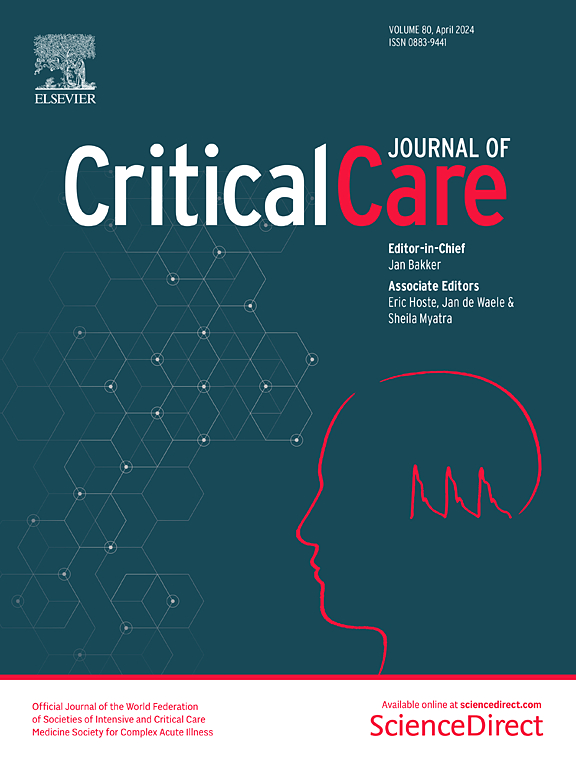Association between mean hemodynamic variables during the first 24 h and outcomes in cardiogenic shock: identification of clinically relevant thresholds
IF 8.8
1区 医学
Q1 CRITICAL CARE MEDICINE
引用次数: 0
Abstract
Cardiogenic shock (CS) remains a critical condition with high mortality rates despite advances in treatment. This study aims to comprehensively evaluate both macrocirculatory and tissue perfusion variables over the initial 24 h post-admission to determine their impact on patient prognosis and identify potential hemodynamic thresholds for optimal outcomes. Secondary aims were to explore the correlation between macrocirculatory and tissue perfusion variables. This is a post hoc analysis of data from two prospective studies, OptimaCC (NCT01367743) and MicroShock (NCT03436641), involving only patients with CS. Both studies applied regular assessment of hemodynamic variables at specific time points (admission, 6, 12, and 24 h) to ensure consistency in data collection, enrolling 118 patients between September 2011 and July 2021, with similar inclusion criteria and care processes. The median age of the cohort was 69 years, 59% being male. The primary outcome, 30-day mortality, occurred in 37% of patients. Average macrocirculation variables over the first 24 h of CS such as mean arterial pressure (MAP), cardiac output (CO), cardiac index (CI), and cardiac power index (CPI) were significantly lower in patients meeting the primary outcome. Accordingly, average tissue perfusion variables (ΔPCO2 and ΔPCO2/C(a-v)O2) over the first 24 h of CS were also consistently impaired in patients meeting the primary outcome. The optimal clinically relevant thresholds of the first 24 h time course for poor outcomes, closely approximating the optimal values identified in the analysis, were: mean SAP < 95 mmHg, MAP < 70 mmHg, CO < 3.5 L/min, CI ≤ 1.8 L/min/m2, CPI < 0.27 W/m2, ScvO2 < 70%, ΔPCO2 ≥ 9 mmHg, and ΔPCO2/C(a-v)O2 ≥ 1.5 mmHg/mL. This study is the first to identify critical hemodynamic thresholds, encompassing both macrocirculatory and tissue perfusion variables, within the initial 24 h of CS that are associated with adverse outcomes. The identified thresholds suggest specific hemodynamic targets that may guide resuscitation strategies.前24小时平均血流动力学变量与心源性休克结局之间的关联:临床相关阈值的确定
心源性休克(CS)仍然是一种死亡率很高的危重疾病,尽管治疗取得了进展。本研究旨在综合评估入院后最初24小时内的大循环和组织灌注变量,以确定其对患者预后的影响,并确定最佳结果的潜在血流动力学阈值。次要目的是探讨大循环和组织灌注变量之间的相关性。这是对两项前瞻性研究OptimaCC (NCT01367743)和MicroShock (NCT03436641)数据的事后分析,仅涉及CS患者。两项研究均在特定时间点(入院、6、12和24小时)对血流动力学变量进行定期评估,以确保数据收集的一致性,在2011年9月至2021年7月期间纳入118名患者,纳入标准和护理流程相似。该队列的中位年龄为69岁,59%为男性。主要结局是30天死亡率,37%的患者出现。CS前24小时的平均大循环变量,如平均动脉压(MAP)、心输出量(CO)、心脏指数(CI)和心功率指数(CPI)在满足主要结局的患者中显著降低。因此,在达到主要结局的患者中,CS前24小时的平均组织灌注变量(ΔPCO2和ΔPCO2/C(a-v)O2)也持续受损。不良结果前24小时的最佳临床相关阈值与分析中确定的最佳值非常接近:平均SAP < 95 mmHg, MAP < 70 mmHg, CO < 3.5 L/min, CI≤1.8 L/min/m2, CPI < 0.27 W/m2, ScvO2 < 70%, ΔPCO2≥9 mmHg, ΔPCO2/C(a-v)O2≥1.5 mmHg/mL。该研究首次确定了与不良结局相关的CS最初24小时内的关键血流动力学阈值,包括大循环和组织灌注变量。确定的阈值提示可能指导复苏策略的特定血流动力学目标。
本文章由计算机程序翻译,如有差异,请以英文原文为准。
求助全文
约1分钟内获得全文
求助全文
来源期刊

Critical Care
医学-危重病医学
CiteScore
20.60
自引率
3.30%
发文量
348
审稿时长
1.5 months
期刊介绍:
Critical Care is an esteemed international medical journal that undergoes a rigorous peer-review process to maintain its high quality standards. Its primary objective is to enhance the healthcare services offered to critically ill patients. To achieve this, the journal focuses on gathering, exchanging, disseminating, and endorsing evidence-based information that is highly relevant to intensivists. By doing so, Critical Care seeks to provide a thorough and inclusive examination of the intensive care field.
 求助内容:
求助内容: 应助结果提醒方式:
应助结果提醒方式:


